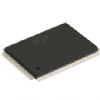Features: • Fast access times: 6.0, 6.5, 7.0, and 8.0 ns
• Fast clock speed: 150, 133, 117, and 100 MHz
• 1 ns set-up time and hold time
• Fast OE access times: 3.5 ns and 4.0 ns
• 3.3V 5% and +10% power supply
• 3.3V or 2.5V I/O supply
• 5V tolerant inputs except I/Os
• Clamp diodes to VSS at all inputs and outputs
• Common data inputs and data outputs
• Byte Write Enable and Global Write control
• Multiple chip enables for depth expansion:three chip enables for TA(GVTI)/A(CY) package version and two chip enables for B(GVTI)/BG(CY) and T(GVTI)/AJ(CY) package versions
• Address pipeline capability
• Address, data and control registers
• Internally self-timed Write Cycle
• Burst control pins (interleaved or linear burst sequence)
• Automatic power-down for portable applications
• JTAG boundary scan for B and T package version
• Low profile 119-bump, 14-mm x 22-mm PBGA (Ball Grid Array) and 100-pin TQFP packages
Pinout Specifications(Above which the useful life may be impaired. For user guidelines only, not tested.)
Specifications(Above which the useful life may be impaired. For user guidelines only, not tested.)
Voltage on VCC Supply Relative to VSS ......... 0.5V to +4.6V
VIN............................................................0.5V to VCC+0.5V
Storage Temperature (plastic).................55°C to +150°C
Junction Temperature ...............................................+150°C
Power Dissipation.......................................................... 1.0W
Short Circuit Output Current ....................................... 50 mADescriptionThe Cypress Synchronous Burst SRAM GVT71256B36/CY7C1361A and GVT71512B18/CY7C1363A family employs highspeed,low-power CMOS designs using advanced triple-layer polysilicon, double-layer metal technology. Each memory cell consists of four transistors and two high-valued resistors.
The GVT71256B36/CY7C1361A and GVT71512B18/CY7C1363A SRAMs integrate 262,144x36 and 524,288x18 SRAM cells with advanced synchronous peripheral circuitry and a 2-bit counter for internal burst operation. All synchronous inputs are gated by registers controlled by a positiveedge-triggered Clock Input (CLK). The synchronous inputs of GVT71256B36/CY7C1361A and GVT71512B18/CY7C1363A include all addresses, all data inputs, address-pipelining Chip Enable (CE), depth-expansion Chip Enables (CE2 and CE2),Burst Control Inputs (ADSC, ADSP, and ADV), Write Enables (BWa, BWb, BWc, BWd, and BWE), and Global Write (GW).However, the CE2 chip enable input is only available for TA(GVTI)/A(CY) package version.
Asynchronous inputs of GVT71256B36/CY7C1361A and GVT71512B18/CY7C1363A include the Output Enable (OE) and burst mode control (MODE). The data outputs (Q), enabled by OE, are also asynchronous.
Addresses and chip enables of GVT71256B36/CY7C1361A and GVT71512B18/CY7C1363A are registered with either Address Status Processor (ADSP) or Address Status Controller (ADSC) input pins. Subsequent burst addresses can be internally generated as controlled by the Burst Advance pin (ADV).
Address, data inputs, and write controls of GVT71256B36/CY7C1361A and GVT71512B18/CY7C1363A are registered on-chip to initiate self-timed WRITE cycle. WRITE cycles can be one to four bytes wide as controlled by the write control inputs.Individual byte write allows individual byte to be written. BWa controls DQa. BWb controls DQb. BWc controls DQc. BWd controls DQd. BWa, BWb, BWc, and BWd can be active only with BWE being LOW. GW being LOW causes all bytes to be written. The x18 version only has 18 data inputs/outputs (DQa and DQb) along with BWa and BWb (no BWc, BWd, DQc, and DQd).
For the B(GVTI)/BG(CY) and T(GVTI)/AJ(CY) package versions,four pins are used to implement JTAG test capabilities: Test Mode Select (TMS), Test Data-In (TDI), Test Clock (TCK),and Test Data-Out (TDO). The JTAG circuitry is used to serially shift data to and from the device. JTAG inputs use LVTTL/LVCMOS levels to shift data during this testing mode of operation. The TA package version does not offer the JTAG capability.
The GVT71256B36 and GVT71512B18 operate from a +3.3V power supply. All inputs and outputs are LVTTL compatible.

 GVT71256B36 Data Sheet
GVT71256B36 Data Sheet







